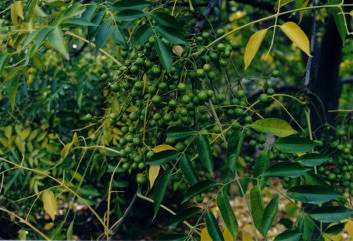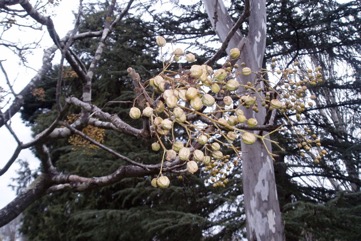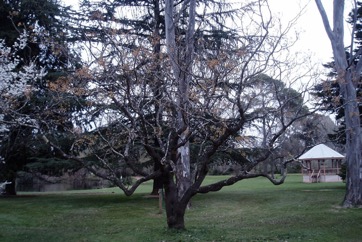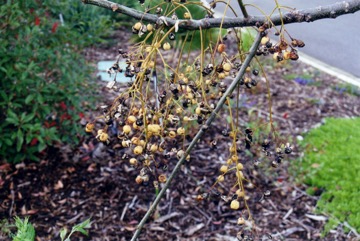Bead tree, Cape lily

A tropical plant. It is naturalised all over India and in many tropical countries. It can grow from tropical to temperate places. It needs well drained soil. It needs to grow in full sun. It can stand light frosts. It is very drought tolerant. In East Africa it grows from sea level to 2,000 m altitude. In Sikkim it grows between 500-1,800 m above sea level. In Argentina it grows below 500 m above sea level. It grows in salty soils. It can grow in arid places. In Melbourne Botanical Gardens. In the Cairns Botanical Gardens. It suits hardiness zones 8-12.
Also known as:
Abori esing, Arebevu, Bakain, Bakaina, Bakam limbodo, Bitter lian, Bobaneemp hang, Chinaberry, Deikna, Dieng-jah-rasang, Drek, False sycamore, Ghoraneem, Ghoranim, Gringging, Hlim hierm, Hutchu bevu, Indian lilac, Indijska lipovka, Kadu khajur, Kala khajur, Karabil, Karinvembu, Ku lian pi, Lapsi, Lashi, Lian, Lien, Lila, Maha neem, Mahanim, Mahanimba, Malai vembu, Mindi kecil, Mindi, Neemtita, Padrai, Pan-tama, Paraiso, Pejri, Persian lilac, Pride of India, Shilasii, Silot-kung, Sima veppu, Syringa, Thamaga, Theikhomchom, Thinbaw-pan-tama, Turaka vepa, White cedar
Synonyms
- Melia composita Willd.
- Melia dubia auct.(non Cav.) How et T Chen
- Melia dubia Cav.
- Melia japonica G. Don
- Melia orientalis M. Roem.
- Melia toosendan Sieb. et Zucc.
- and others
Edible Portion
- Fruit (Poisonous), Gum, Leaves, Flowers, Vegetable, Caution
Where does Bead tree grow?
Found in: Africa, Algeria, America, Andamans, Angola, Arabia, Argentina, Asia, Australia, Bahamas, Bangladesh, Bermuda, Bhutan, Botswana, Brazil, Britain, Burkina Faso, Central Africa, Central America, China, Christmas Island, Colombia, Congo DR, Cook Island, Costa Rica, Côte d'Ivoire, Cuba, Cyprus, Dominican Republic, East Africa, East Timor, Easter Island, Egypt, El Salvador, Ethiopia, Europe, Fiji, France, Gambia, Germany, Ghana, Greece, Guadeloupe, Guatemala, Guyana, Haiti, Hawaii, Himalayas, India, Indochina, Indonesia, Iran, Iraq, Israel, Italy, Ivory Coast, Jamaica, Japan, Kenya, Korea, Laos, Libya, Madagascar, Malawi, Malaysia, Marquesas, Martinique, Mediterranean, Mexico, Micronesia, Mozambique, Myanmar, Namibia, Nauru, Nepal, New Caledonia, Nigeria, Norfolk Island, North Africa, North America, Northeastern India, Pacific, Pakistan, Panama, Papua New Guinea, PNG, Paraguay, Peru, Philippines, Pohnpei, Portugal, Puerto Rico, Reunion, Rotuma, Sao Tome and Principe, SE Asia, Senegal, Seychelles, Sierra Leone, Sikkim, Slovenia, Solomon Islands, South Africa, Southern Africa, South America, Spain, Sri Lanka, St Helena, Sudan, Swaziland, Syria, Taiwan, Tanzania, Thailand, Timor-Leste, Tonga, Trinidad-Tobago, Tunisia, Turkey, Tuvalu, Uganda, Uruguay, United States, Vanuatu, Venezuela, Vietnam, West Africa, West Indies, West Timor, Yap, Yugoslavia, Zambia, Zimbabwe
Notes: Used as a medicine in Indonesia. It has anticancer properties. There are 2-3 (10-37) Melia species. It can become invasive.
Growing Bead tree, Cape lily
Cultivation: Plants are grown from seed. Seed need to be planted fresh. They can also be grown from cuttings. It can be cut back and will re-grow.
Edible Uses: CAUTION: The fruit are very poisonous. (Six can kill a person). The berries have been recorded as eaten. They are also used for an alcoholic drink. Caution: Alcohol is a cause of cancer. The young leaves are used in medicine and also recorded as eaten. They are roasted or fried. They are also used in curries. A kind of toddy is made by tapping the tree. Many parts of the tree are dangerously narcotic. The flowers are eaten as a vegetable. They are bitter.
Production: It is a fast growing tree.
Nutrition Info
per 100g edible portion| Edible Part | Energy (kcal) | Protein (g) | Iron (mg) | Vitamin A (ug) | Vitamin c (mg) | Zinc (mg) | % Water |
|---|---|---|---|---|---|---|---|
| Fruit | 67 | 1.3 | - | - | - | - | 81.9 |
Bead tree, Cape lily Photos




References
Ambasta, S.P. (Ed.), 2000, The Useful Plants of India. CSIR India. p 361
Barwick, M., 2004, Tropical and Subtropical Trees. A Worldwide Encyclopedic Guide. Thames and Hudson p 271
Bekele-Tesemma A., Birnie, A., & Tengnas, B., 1993, Useful Trees and Shrubs for Ethiopia. Regional Soil Conservation Unit. Technical Handbook No 5. p 308
Bole, P.V., & Yaghani, Y., 1985, Field Guide to the Common Trees of India. OUP p 87
Bremness, L., 1994, Herbs. Collins Eyewitness Handbooks. Harper Collins. p 65
Bunderson, W. T. et al, 2002, Common Agroforestry Species in Malawi. Malawi Agroforestry Extension Project, Pubication No. 46, Lilongwe. p 36
Burkill, H. M., 1985, The useful plants of west tropical Africa, Vol. 4. Kew.
Burkill, I.H., 1966, A Dictionary of the Economic Products of the Malay Peninsula. Ministry of Agriculture and Cooperatives, Kuala Lumpur, Malaysia. Vol 2 (I-Z) p 1465 (Also as Melia dubia)
Cabalion, P. and Morat, P., 1983, Introduction le vegetation, la flore et aux noms vernaculaires de l'ile de Pentcoste (Vanuatu), In: Journal d'agriculture traditionnelle et de botanique appliquee JATBA Vol. 30, 3-4
Cooper, W. and Cooper, W., 2004, Fruits of the Australian Tropical Rainforest. Nokomis Editions, Victoria, Australia. p 292
Cronin, L., 1989, The Concise Australian Flora. Reed. p 179
Cundall, P., (ed.), 2004, Gardening Australia: flora: the gardener's bible. ABC Books. p 886
Dash, S. S. & Singh, P. Trees of Sikkim p 98 (As Melia dubia)
Dharani, N., 2002, Field Guide to common Trees & Shrubs of East Africa. Struik. p 127
Doran, J.C., & Turnbull, J.W. (Eds), 1997, Australian Trees and Shrubs: species for land rehabilitation and farm plantings in the tropics. ACIAR Monograph No 24. p 328
Engel, D.H., & Phummai, S., 2000, A Field Guide to Tropical Plants of Asia. Timber Press. p 49
Etherington, K., & Imwold, D., (Eds), 2001, Botanica's Trees & Shrubs. The illustrated A-Z of over 8500 trees and shrubs. Random House, Australia. p 475
Flora of Australia Volume 49, Oceanic Islands 1, Australian Government Publishing Service, Canberra. (1994) p 246
Flora of Pakistan. www.eFloras.org
Food Composition Tables for use in East Asia FAO http://www.fao.org/infoods/directory No. 916
Fowler, D. G., 2007, Zambian Plants: Their Vernacular Names and Uses. Kew. p 47
Gardner, S., et al, 2000, A Field Guide to Forest Trees of Northern Thailand, Kobfai Publishing Project. p 111
Greig, D., 1996, Flowering Natives for Home Gardens. Angus & Robertson. p 268
Grubben, G. J. H. and Denton, O. A. (eds), 2004, Plant Resources of Tropical Africa 2. Vegetables. PROTA, Wageningen, Netherlands. p 563
Hedrick, U.P., 1919, (Ed.), Sturtevant's edible plants of the world. p 407
Heywood, V.H., Brummitt, R.K., Culham, A., and Seberg, O. 2007, Flowering Plant Families of the World. Royal Botanical Gardens, Kew. p 208
Hibbert, M., 2002, The Aussie Plant Finder 2002, Florilegium. p 195
Holliday, I., 1989, A Field Guide to Australian Trees. Hamlyn. p 264
http://www.botanic-gardens-ljubljana.com/en/plants
Hussey, B.M.J., Keighery, G.J., Cousens, R.D., Dodd, J., Lloyd, S.G., 1997, Western Weeds. A guide to the weeds of Western Australia. Plant Protection Society of Western Australia. p 176
Jackes, B.R., 2001, Plants of the Tropics. Rainforest to Heath. An Identification Guide. James Cook University. p 63
Jadhav, R., et al, 2015, Forest Foods of Northern Western Ghats: Mode of Consumption, Nutrition and Availability. Asian Agri-History Vol. 19, No. 4: 293-317
Kachenchart, B., et al, 2008, Phenology of Edible Plants at Sakaerat Forest. In Proceedings of the FORTROP II: Tropical Forestry Change in a Changing World. Bangkok, Thailand.
Kintzios, S. E., 2006, Terrestrial Plant-Derived Anticancer Agents and Plant Species Used in Anticancer research. Critical Reviews in Plant Sciences. 25: pp 79-113
Kiple, K.F. & Ornelas, K.C., (eds), 2000, The Cambridge World History of Food. CUP p 1754
Krishen P., 2006, Trees of Delhi, A Field Guide. DK Books. p 302
Kumar, A., et al, 2012, Ethnobotanical Edible Plant Biodiversity of Lepcha Tribes. Indian Forester, 138 (9):798-803 (As Melia composita)
Latham, P & Mbuta, A., 2017, Useful Plants of Central Province, Democratic Republic of Congo. Volume 2. Salvation Army p 26
Little, E.L., 1980, National Audubon Society Field Guide to North American Trees. Alfred A. Knopf. p 541
Llamas, K.A., 2003, Tropical Flowering Plants. Timber Press. p 276
Lord, E.E., & Willis, J.H., 1999, Shrubs and Trees for Australian gardens. Lothian. p 18
Marinelli, J. (Ed), 2004, Plant. DK. p 462
Mbuya, L.P., Msanga, H.P., Ruffo, C.K., Birnie, A & Tengnas, B., 1994, Useful Trees and Shrubs for Tanzania. Regional Soil Conservation Unit. Technical Handbook No 6. p 340
McMakin, P.D., 2000, Flowering Plants of Thailand. A Field Guide. White Lotus. p 29
Melzer, R. & Plumb, J., 2011, Plants of Capricornia. Belgamba, Rockhampton. p 178
Nicholson, N & H., 1996, Australian Rainforest Plants, Terania Rainforest Publishing. NSW. p 46
Paczkowska, G. & Chapman, A.R., 2000, The Western Australian Flora. A Descriptive Catalogue. Western Australian Herbarium. p 294
Palgrave, K.C., 1996, Trees of Southern Africa. Struik Publishers. p 381
Pandey, K. C. & Pande, N., 2016, Ethnobotanical Documentation of Wild Edible Plants used by Gujjar Community of Tarai West Forest Division Ramnagar, Nainital, India, Current World Environment. Vol. 11(3), 808-818
Patiri, B. & Borah, A., 2007, Wild Edible Plants of Assam. Geethaki Publishers. p 25
Pfoze, N. L., et al, 2012, Survey and assessment of floral diversity on wild edible plants from Senapati district of Manipur, Northeast India. Journal of Biodiversity and Environmental Sciences. 1(6):50-52 (As Melia birmanica)
Plants for a Future database, The Field, Penpol, Lostwithiel, Cornwall, PL22 0NG, UK. http://www.scs.leeds.ac.uk/pfaf/
Plants of Haiti Smithsonian Institute http://botany.si.edu/antilles/West Indies
PROSEA handbook Volume 9 Plants yielding non-seed carbohydrates. p 188
Ratcliffe D & P., 1987, Australian Native Plants for Indoors. Little Hills press. p 105
Recher, P, 2001, Fruit Spirit Botanical Gardens Plant Index. www.nrg.com.au/~recher/ seedlist.html p 6
Royal Botanic Gardens, Kew (1999). Survey of Economic Plants for Arid and Semi-Arid Lands (SEPASAL) database. Published on the Internet; http://www.rbgkew.org.uk/ceb/sepasal/internet [Accessed 3rd May 2011]
Ruiters-Welcome, A. K., 2019, Food plants of southern Africa. Ph.D. thesis. Univ. of Johannesburg p 78
Sakar, A. & Das, A. P., 2018, The traditional knowledge on edible wild leafy vegetables of Rabha Tribe in Duars of North Bengal: a potential reinforcement to food security. Pleione 12(2): 275 - 281. 2018.
Sarma, H., et al, 2010, Updated Estimates of Wild Edible and Threatened Plants of Assam: A Meta-analysis. International Journal of Botany 6(4): 414-423
Savita, et al, 2006, Studies on wild edible plants of ethnic people in east Sikkim. Asian J. of Bio Sci. (2006) Vol. 1 No. 2 : 117-125 (As Melia dubia)
Song, M., et al, 2013, Traditional knowledge of wild edible plants in Jeju Island, Korea. Indian Journal of Traditional Knowledge. 12(2) pp 177-194
Sp. pl. 1:384. 1753 (type species)
Staples, G.W. and Herbst, D.R., 2005, A tropical Garden Flora. Bishop Museum Press, Honolulu, Hawaii. p 399
Sukarya, D. G., (Ed.) 2013, 3,500 Plant Species of the Botanic Gardens of Indonesia. LIPI p 674
Sundriyal, M., et al, 1998, Wild edibles and other useful plants from the Sikkim Himalaya, India. Oecologia Montana 7:43-54 (As Melia composita)
Sundriyal, M., et al, 2004, Dietary Use of Wild Plant Resources in the Sikkim Himalaya, India. Economic Botany 58(4) pp 626-638 (As Melia composita)
Swaminathan, M.S., and Kochnar, S.L., 2007, An Atlas of Major Flowering Trees in India. Macmillan. p 80
Swaziland's Flora Database http://www.sntc.org.sz/flora
Thaman, R. R, 2016, The flora of Tuvalu. Atoll Research Bulletin No. 611. Smithsonian Institute p 100
Townsend, K., 1994, Across the Top. Gardening with Australian Plants in the tropics. Society for Growing Australian Plants, Townsville Branch Inc. p 296
Valder, P., 1999, The Garden Plants of China. Florilegium. p 305
van Wyk, B, van Wyk, P, and van Wyk B., 2000, Photographic guide to Trees of Southern Africa. Briza. p 200
White, F., Dowsett-Lemaire, F. and Chapman, J. D., 2001, Evergreen Forest Flora of Malawi. Kew. p 365
Williams, J.B., Harden, G.J., and McDonald, W.J.F., 1984, Trees and shrubs in rainforests of New South Wales and Southern Queensland. Univ. of New England, Armidale. p 21
Williamson, J., 2005, Useful Plants of Malawi. 3rd. Edition. Mdadzi Book Trust. p 167
Wijayakusuma, H.M.H., et al, 1996, Tanaman Berkhasiat Obat Di Indonesia. Pustaka Kartini. p 94
World Checklist of Useful Plant Species 2020. Royal Botanic Gardens, Kew
Zizka, G., 1991, Flowering Plants of Easter Island. Palmarum Hortus Francofurtensis